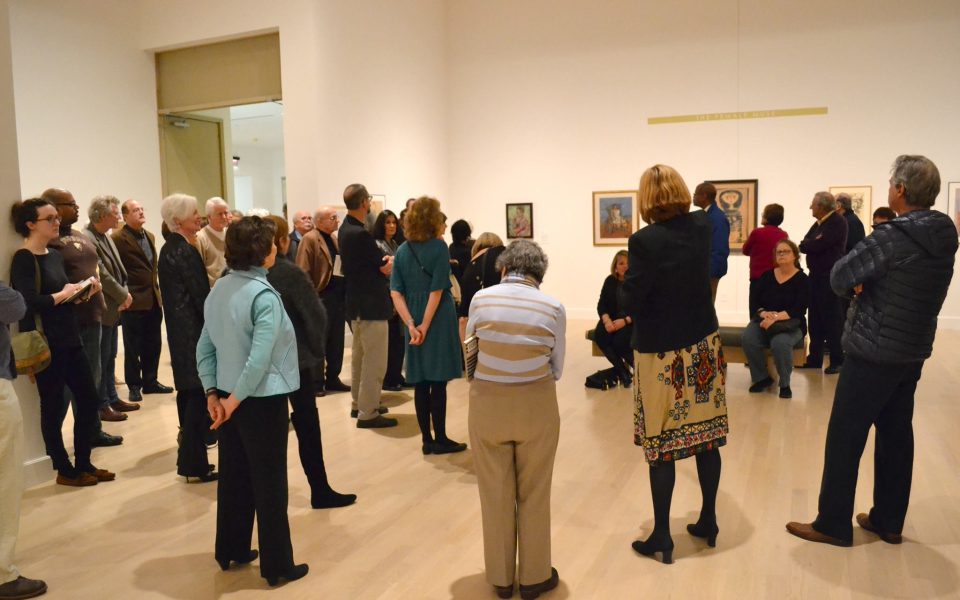Photo credit: Loring Mortenson
Part of the mission of the Pan American Modernism exhibit is to debunk ethnocentric attitudes about modernism in movements like muralism and abstract expressionism.
by Joanna Rutter
To be still in the hushed McDowell Gallery at the Weatherspoon Art Museum in Greensboro is to stand in the center of almost a century of conversation, competition and collaboration. These voices are anything but quiet — violent sketches from muralists so controversial they carried guns while they painted are placed adjacent to jarring geometric abstractions and provocative, haunting photography.
This immersing experience is open to the public in Pan American Modernism: Avant-Garde Art in Latin America and the United States, a traveling exhibit from the University of Miami’s Lowe Art Museum that will be at UNCG’s art museum until early May, featuring 70 significant artists from Argentina, Cuba, Mexico and the United States, among other nations.
Pan American Modernism introduces visitors to the dialogue in modernism that occurred across the Americas between 1919 and 1979. For the amateur viewer, the exhibit is thankfully grouped into five artistic subcategories for easier perusal: Mexican muralism, the female muse, abstract expressionism, modernist photography and geometric abstraction.
And it’s highly likely that most, if not all attendees, would be amateurs when it comes to understanding the layered complexity of the Pan-American modern art movement, due to having been served a modernism narrative that falsely places the United States at the movement’s center, according to Curator of Collections Elaine Gustafson.
“I never even studied Latin American art; my education was biased in that I heard the US came up with abstract expressionism,” Gustafson said. “Well, actually everyone was traveling, meeting and sharing ideas in Paris, New York, Mexico City…. We never studied this in art history class.”
Local artist Noé Katz, a painter and sculptor who splits his time between his native Mexico City and Greensboro, was slightly critical of the exhibit’s ability to properly present this movement in Latin American art, having hoped to see the US-centric narrative dismantled by a depth and range of artists featured.
“It’s nice,” he allowed in an interview, with a shrug of his shoulders.
“It’s a great exhibit for people who have never even heard of, you know, Diego Rivera or Frida Kahlo,” he said, invoking the names of one of the leaders of the Mexican mural movement and a feminist icon famous for her self-portraits influenced by indigenous Mexican art. One Rivera piece is in the collection, a small sketch that couldn’t be more than a few inches high.
“Rivera has pieces as big as this entire wall,” Katz said, gesturing to the ceiling. “This is nothing.”
The collection is successful in making connections between artists, such as the friendship between Joaquín Torres-García — a Uruguayan avant-garde artist who founded the group Cercle et Carré in Paris in 1929 — and Pierre Daura, who encouraged Torres-García to move to France and arranged his first show 1926. The influence the two had over each other’s work is apparent when viewing Daura’s “Étude No. 1 Analise” and Torres-García’s “Composición”, both of which deconstruct an image into rectangular abstractions. If either of the pieces evokes a sense of déjà vu, it’s because both artists rubbed elbows with Piet Mondrian just as he was beginning to paint his famous squares.
The Weatherspoon has packed the remainder of the spring with events that will accompany the exhibit, including a Pablo Neruda bilingual poetry reading on April 4 and a Feb. 18 screening of Chico & Rita, an animated film about the modernism movement in art and how it influenced and was influenced by jazz.
Gustafson said the bilingual programming for exhibit events is part of a larger effort to make the museum more accessible.
“It’ll make it approachable,” she said. “We’re making inroads to people who didn’t know we existed.”
And yet, regardless of programming and background stories, the exhibit’s evocative power lies within the strength of the individual works themselves. Certain pieces in the collection can be enjoyed without any context and should not be missed, such as the eerie deconstructionism of Guillermo Wiedemann’s “Surreal Native Woman,” the passionate energy conveyed through almost-neon colors in the haunting “Lovers” by Sacha Tebo, or the quilt-like, rich hues of Luis Hernández Cruz’s “Subsuelo.”
Here’s another story worth hearing; After Rivera, perhaps the most notable artist present in the collection is his contemporary David Alfaro Siqueiros, a large-scale muralist — he “painted with a gun, just in case,” according to Katz — who spent time in prison for attempting to assassinate Leon Trotsky. His “Jesus” is worth hunting down in the gallery for a long and unsettling staring contest.
Katz passionately said to a group of friends that when Siqueiros was freed in the late 1930s, he moved to New York, where he left an impression on a young Jackson Pollock by teaching him the splatter-paint method for which Pollock is now so well known.
The fact that it’s likely you’ve heard Pollock’s name and not Siqueiros’ makes it all the more necessary to experience this exhibition before it closes in May.
Visit Pan American Modernism: Avant-Garde Art in Latin America and the United States at the Weatherspoon Museum at UNCG, which will run until May 1. The full calendar of events complementing the exhibit, along with museum hours, can be found at weatherspoon.uncg.edu.
Join the First Amendment Society, a membership that goes directly to funding TCB‘s newsroom.
We believe that reporting can save the world.
The TCB First Amendment Society recognizes the vital role of a free, unfettered press with a bundling of local experiences designed to build community, and unique engagements with our newsroom that will help you understand, and shape, local journalism’s critical role in uplifting the people in our cities.
All revenue goes directly into the newsroom as reporters’ salaries and freelance commissions.


Leave a Reply